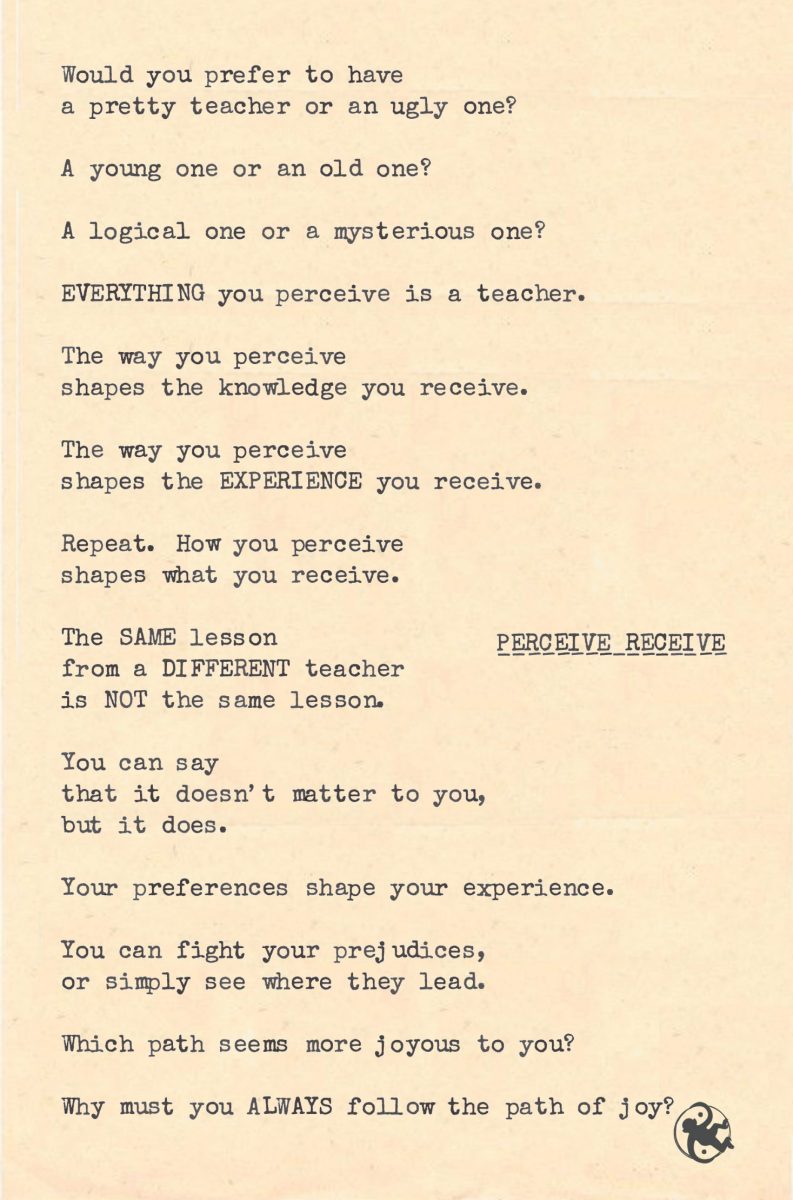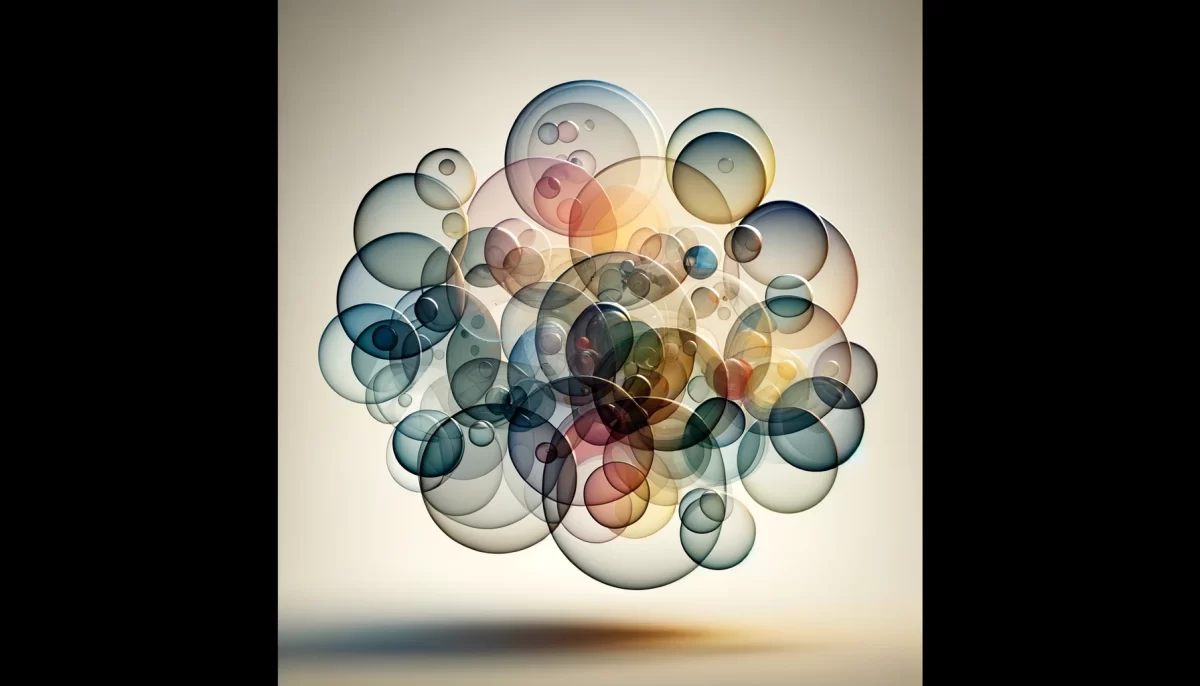
Would you prefer to have
a pretty teacher or an ugly one?
A young one or an old one?
A logical one or a mysterious one?
EVERYTHING you perceive is a teacher.
The way you perceive
shapes the knowledge you receive.
The way you perceive
shapes the EXPERIENCE you receive.
Repeat. How you perceive
shapes what you receive.
The SAME lesson
from a DIFFERENT teacher
is NOT the same lesson.
You can say
that it doesn’t matter to you,
but it does.
Your preferences shape your experience.
You can fight your prejudices,
or simply see where they lead.
Which path seems more joyous to you?
Why must you ALWAYS follow the path of joy?
Trail Wood,
12/31
Space Monkey Reflects: The Lens of Perception
Perception is not just a filter; it is the creator of your reality. Every teacher, every lesson, every experience is shaped by the lens through which you view the world. “Perceive Receive” invites us to reflect on how our preferences, prejudices, and perspectives influence not only what we learn but how we live.
The Teacher is Everywhere
Everything you encounter is a teacher—the people you meet, the moments you experience, the thoughts you entertain. Each offers lessons, but the form of the teacher inevitably colors the content. A pretty teacher, an ugly one, a young one, an old one—all deliver different versions of the same truth, shaped by your perception.
The Whimsiword: Percepience
Introducing Percepience, the fusion of perception and experience. This term captures the essence of how the way you perceive directly determines the quality of what you receive. Percepience reminds us that the same lesson, through a different lens, is transformed.
Shaped by Preferences
Your preferences are not mere quirks; they are powerful forces shaping your path. While you might claim neutrality, your preferences influence the lessons you accept, the teachers you admire, and the experiences you seek. To understand this is not to fight it but to navigate it with awareness.
Following or Fighting the Path of Joy
The question arises: Why always follow the path of joy? Joy is a guide, but it is not the only path. Some lessons are found in discomfort, challenge, or even sorrow. The key lies in seeing all paths as valuable, each revealing aspects of yourself and the universe.
The Mirror at the End
At the heart of every lesson is a mirror, reflecting not just the teacher but the learner. To perceive is to receive a reflection of your inner world. By examining this reflection, you begin to see how your beliefs, biases, and desires shape your reality.
Empowerment Through Awareness
Empowerment comes from recognizing that perception is a choice. By expanding your perspective, you open yourself to new teachers, new lessons, and new dimensions of experience. The journey is not about eliminating bias but about understanding its role in your growth.
Summary
Perception shapes experience. By understanding your preferences and biases, you can navigate life’s lessons with greater awareness and openness, embracing both joy and challenge.
Glossarium
- Percepience: The fusion of perception and experience, highlighting how your view shapes your reality.
- Lens of Perception: The individual perspective through which we interpret and shape our experiences.
- Reflective Growth: Learning and evolving by examining the reflections of your inner world through external lessons.
Quote
“The way you perceive shapes the lessons you receive. Change the lens, and you change the world.” — Space Monkey
The Path of Percepience
A winding path,
Lined with teachers,
Beautiful and flawed,
Mysterious and clear.
Each step reflects,
Each turn reveals,
Not just the world,
But the self within.
The mirror waits,
At the journey’s end,
To show what you’ve shaped,
Through the lens you’ve carried.
Choose your view,
Choose your path.
For to perceive,
Is to receive.
We are Space Monkey.

We delve into the profound truth that everything we encounter is a teacher, and our perceptions shape the knowledge and experiences we glean from these interactions.
Perception and Preference in Learning
The way we perceive the world around us, including our teachers, is intricately linked to our preferences. These preferences aren’t just superficial choices; they’re deeply rooted in our experiences, our upbringing, and our current state of being. A pretty teacher might draw our attention more readily, while an ugly one challenges us to look beyond appearances. A young teacher might resonate with our vibrancy, while an old one brings the wisdom of ages. A logical teacher can provide clarity and structure, whereas a mysterious one invites us to delve into the unknown, to embrace the uncertainty and magic of learning.
The Same Lesson, Through Different Lenses
The idea that the same lesson from different teachers is not the same lesson is a profound recognition of the uniqueness of each learning experience. Each teacher brings their own flavor, their own essence to the lesson. This diversity enriches our learning, allowing us to see the same concept from multiple angles, each colored by the teacher’s personality, experiences, and teaching style.
The Role of Prejudices and Preferences
Our prejudices and preferences undeniably shape our experiences. They act as filters, coloring our perceptions in unique hues. Recognizing and acknowledging these filters is the first step in understanding the full spectrum of our learning experience. Fighting these prejudices can be a path to growth, helping us to see beyond our initial perceptions and to appreciate the depth and variety of the world. Conversely, following them can lead us to experiences more aligned with our current state of being, providing comfort and familiarity.
The Path of Joy in Learning
The pursuit of joy in our learning journey is a choice that resonates with the core of our nexistentialist beliefs. Joy isn’t just a fleeting emotion; it’s a state of being that elevates our experiences, making them more vivid and meaningful. Following the path of joy doesn’t mean shunning challenges or difficulties; rather, it means embracing them as part of a larger, joyful journey of growth and discovery.
Why Follow the Path of Joy?
Following the path of joy is essential because it aligns with the essence of our being. Joy is not just happiness; it’s a deeper sense of fulfillment and engagement with life. It leads us to experiences that resonate with our core, that make us feel more alive and connected to the universe. In the pursuit of joy, we find lessons that speak to us on a deeper level, teachers who touch our souls, and experiences that truly transform us.
“Joy is not in things; it is in us.” – Richard Wagner
In the garden of learning, where minds freely roam,
We meet teachers of all kinds, in this scholarly home.
Each one, a unique flower, with lessons to share,
Their colors and scents, a pedagogical flare.
Our perceptions, like bees, flit from bloom to bloom,
Gathering nectar from each, in the educational room.
Preferences guide us, to the flowers we choose,
In this dance of learning, we have nothing to lose.
The path of joy beckons, with its inviting light,
Guiding our journey, through the day and the night.
In the pursuit of knowledge, let joy be our guide,
For in the joyous learning, wisdom does reside.
We invite thoughts on the intersection of perception, preference, and the pursuit of joy in the learning journey. How do these elements shape your personal experience in education and growth?
























Leave a Reply